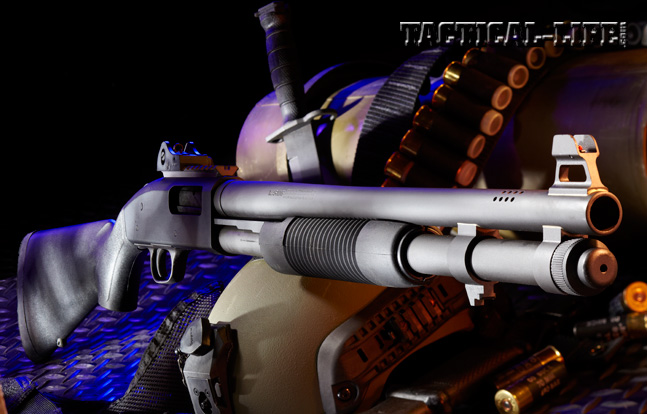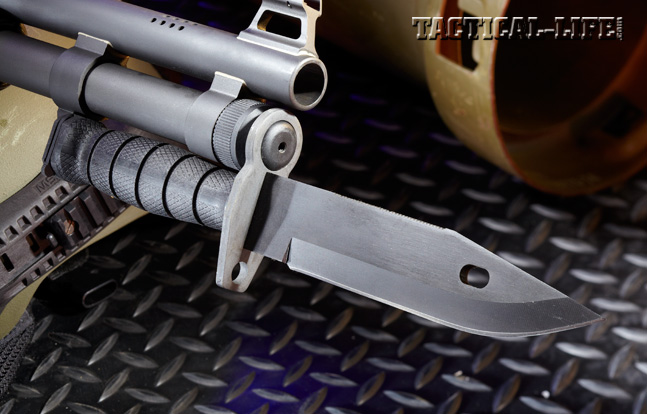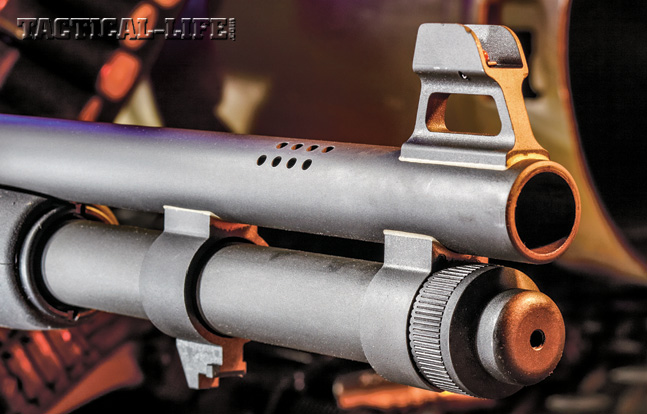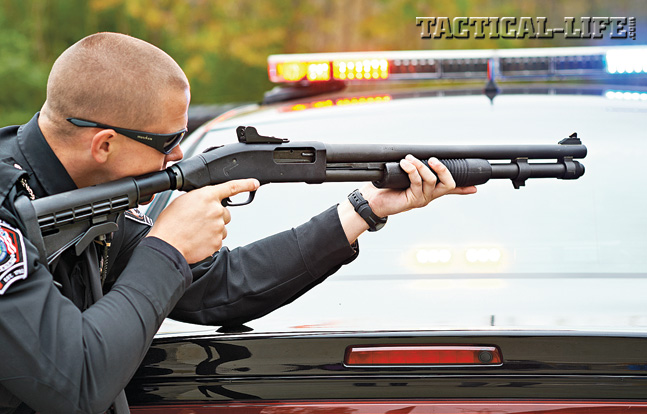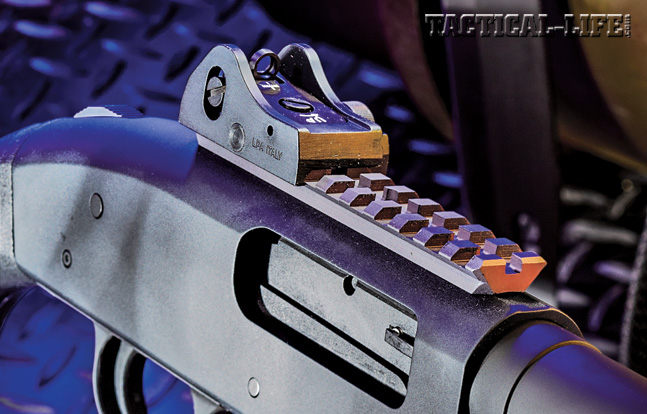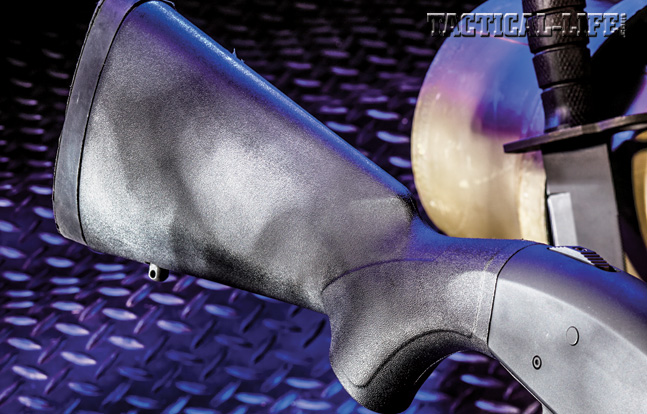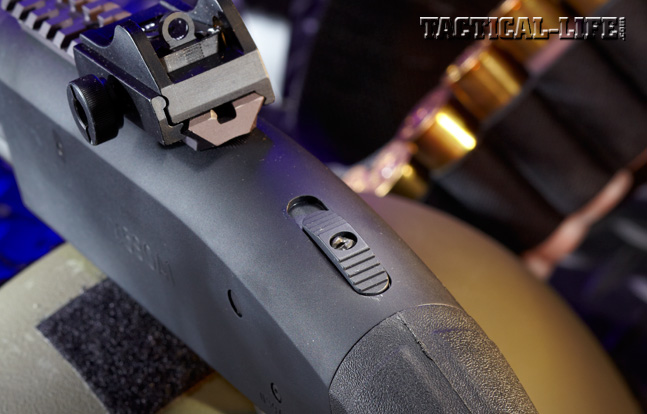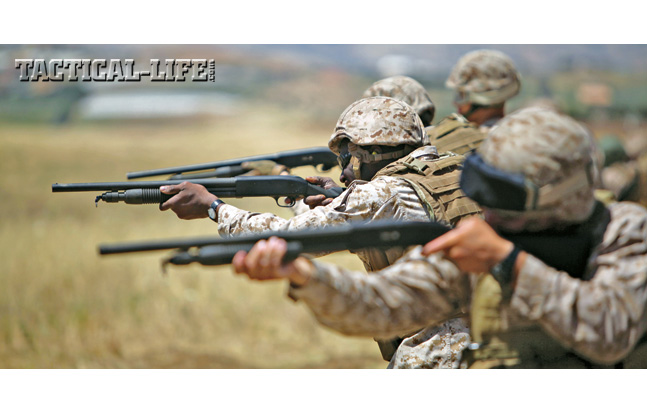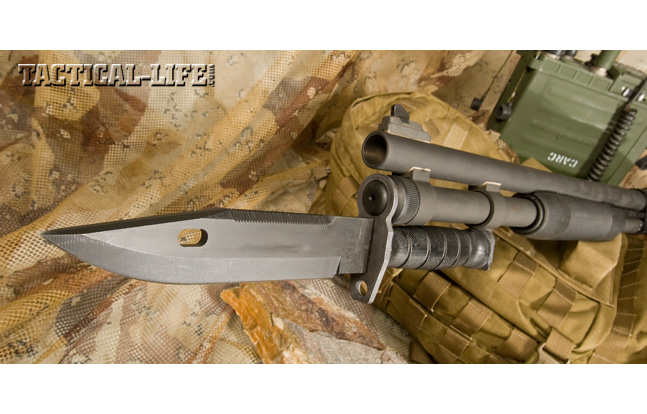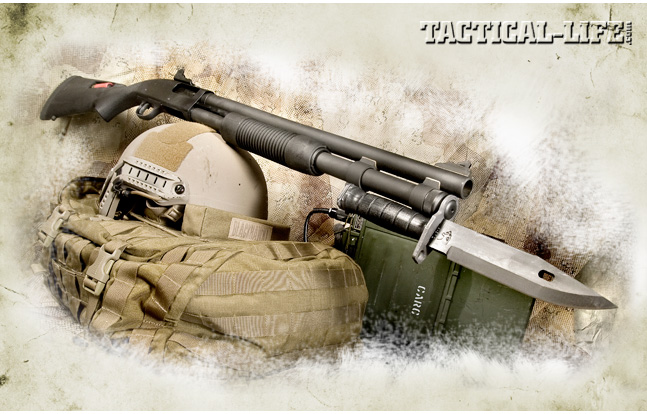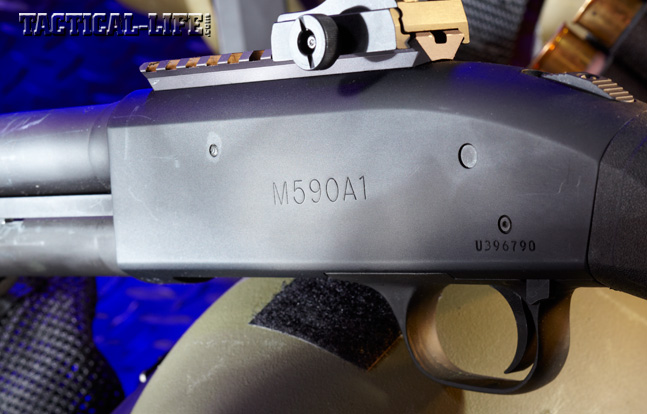A while back, I was looking at Mossberg’s website and noticed that the company offers the Model 590A1 with a bayonet lug and supplied it with an M9 bayonet as an option. Since I had just completed a book on U.S. military shotguns and spent a lot of time discussing trench shotguns, I found the availability of the 590A1 with a bayonet quite intriguing—intriguing enough that I wanted to evaluate it.
It takes a lot for a pump-action combat shotgun to compete with the Remington 870, but Mossberg’s 500 series has made real inroads in the law enforcement market and has been in use for years with the U.S. armed forces. Although the Models 500, 590 and 590A1 have seen service, the 590A1 is the model designed to meet the current 3443G materials requirements for shotguns. These include an aluminum triggerguard and safety as well as a heavy barrel. Reportedly, the heavy barrel was a U.S. Navy requirement to enhance durability.
A military-type 590 or 590A1 is also designed so that the muzzle cap and the spring and follower may be removed for thorough cleaning. Since Mossbergs have seen a lot of use in sand and dirt, this is very desirable. The presence of the bayonet lug on the 590A1 I tested is interesting because there is a 3443G requirement for Type I riot shotguns with heat shields and bayonet lugs. As I understand it, standard Mossberg heat shields won’t fit the heavier-barreled 590A1, but some heat shields have been produced for military 590A1s. If that is the case, I would speculate that the contract was most likely for the USMC, as the Marines have traditionally used shotguns with bayonets mounted.
Advertisement — Continue Reading Below
Continue Reading: Mossberg 590A1 12 Gauge Shotgun | Gun Review

Hands On
My test 590A1 had the bayonet lug but no heat shield. Heat shields look very tactical, and they had applicability in the days when the first trench shotguns were developed in World War I. It was assumed that the shotgun would be fired until it ran dry, then trench raiders would be skewered with the bayonet. The heat shield allowed infantrymen to grasp the barrel for thrusting without burning their hands. Today, just the bayonet lug should suffice even for riot usage. A likely use would be for intimidation when advancing on rioters and firing less-lethal munitions. I’ll discuss that and other tactical uses later.
Advertisement — Continue Reading Below
Before I talk about why I like the idea of the bayonet lug, let me mention some of the other reasons I like the Mossberg 590A1. First, I have a Model 500 that I’ve used for some years and have always found it reliable and durable despite the fact it has the plastic triggerguard and safety switch, which were replaced with the 590A1, making it even more durable. Another feature that enhances the 590A1 and other Mossberg shotguns for combat is the sliding safety on top of the receiver. I find this faster to use when bringing the shotgun into a shooting position than a crossbolt safety.
I am entirely happy with the sights of the 590A1, but it does have a Picatinny rail on top, so one of many red dots can easily be mounted. However, for using slugs at 50 yards or more, I prefer the ghost ring rear sight. My test 590A1 has a 20-inch barrel, which means it also has a longer magazine tube. In close quarters, an 18- or 18.5-inch barrel is handier, and a 14-inch NFA barrel is even better. But, on the other hand, I like the fact that this 590A1’s tube holds eight rounds, and if you’re going to mount the bayonet, the longer tube and barrel provide a bit more reach. Speaking of the barrel, it is ported along the top near the muzzle. When I was firing 3-inch shells, I didn’t take along another shotgun for comparison to see if I noticed that it dampened muzzle rise. I’m assuming it does to some extent. The Mossberg 590A1 12-gauge also has a nice matte black finish—something I prefer for a combat shotgun.
Continue Reading: Mossberg 590A1 12 Gauge Shotgun | Gun Review
Advertisement — Continue Reading Below

Bayonet Uses
Now, let’s talk about the bayonet. I’m sure some readers—possibly many—will be saying, “Why would I want to hang a bayonet on my combat shotgun?” Well, my first answer: You don’t have to. Just because this version of the 590A1 has a bayonet lug and a bayonet doesn’t mean you have to use them. Worst-case scenario: If you run out of ammunition during the zombie apocalypse, your shotgun changes from a club to a pike.
There are valid applications for a shotgun mounting a bayonet, however. In the trenches, the bayonet helped achieve “standoff” distances against attacking German raiders. During WWI and WWII, MPs guarding prisoners found a shotgun loaded with buckshot and mounting a bayonet had a “soothing” effect. Troops on anti-riot duty also found that a rifle or shotgun mounting a bayonet was excellent for dispersing crowds. Having a shotgun loaded with less-lethal ammunition and mounting a bayonet, especially arming troops trained to advance in step (traditionally stamping the lead foot), is useful for crowd control. Even the angriest demonstrators don’t usually want to push towards a bayonet. If the possibility exists of rioters firing on the police or military personnel on duty, some members of the unit may be armed with carbines, while those with shotguns can have buckshot or slugs in their pouches, or they can resort to their handguns.
Advertisement — Continue Reading Below
I can also see an advantage for a shotgun mounting a bayonet during house-clearing operations. When clearing a building and needing to herd occupants into an area, a bayonet on a carbine or shotgun would be quite useful. Psychologically, many people will think, “He probably won’t shoot me, but he might jab me!”
O.K., so that may make some sense to you for police and military users, but what about as a self-defense shotgun? Honestly, I like the 590A1 with the bayonet because I’ve always liked trench guns and it harkens back to them. However, I also see a use for the bayonet on a home-defense shotgun. Hurricanes and other disasters that have been in the news bring out looters and other two-legged predators. Warning them away with a shotgun should work quite well, but warning them away with a shotgun bearing a bayonet should work even better and discourage getting too close during the conversation. Anyone considering grabbing your weapon, too, will have to consider the likelihood of getting stuck or slashed if he does make a grab.
When it comes to home defense, I keep both a shotgun and a pistol next to my bed. If I hear sounds in the night that I can’t identify I generally take my lead from my Airedale. If he alerts and starts to growl, I grab a gun. If he tears from the bedroom while growling, I follow. Should I feel it necessary to search my home with my shotgun, I don’t move through doorways with it shouldered. I carry it at the hip and pulled rearward to make it harder to grab. I also have practiced retention drills. Still, an attached bayonet will help discourage anyone attempting to grab my shotgun—so should the Airedale who would have already encountered him. O.K., I know some of you are saying, “This guy is a nut. I’m not keeping a bayonet on a shotgun next to the bed, where it can fall over and slit my throat!” Have faith, though. It is possible to unsnap the retention snap and mount the bayonet to the 590A1 while leaving the blade sheathed. The sheath may be quickly removed.
Advertisement — Continue Reading Below
Is a bayonet a necessity on a combat shotgun? Definitely not. But whether I mount the bayonet or not, the 590A1 is an excellent fighting scattergun. And, the bayonet does offer options. I like options. For more information, visit mossberg.com or call 203-230-5300.
